Development of Wide-Angle Depolarizing Reflector at 1064 nm
Abstract
:1. Introduction
2. Experiments
2.1. Materials Selection Analysis
2.2. Materials and Software
2.3. Preparation of Thin Film
2.4. Characterization
3. Results and Discussion
3.1. Study on Meonolayer Film
3.2. Theoretical Design of Multilayer Optical Coatings
3.3. Analysis of Optical Control Solutions
3.4. Analysis of Reflection Spectrum
4. Conclusions
Supplementary Materials
Author Contributions
Funding
Institutional Review Board Statement
Informed Consent Statement
Data Availability Statement
Conflicts of Interest
Abbreviations
| List of symbols | |
| Optical admittance | |
| Phase of the film | |
| Angle of incidence | |
| Phase change of the transmitted light | |
| Wavelength of electromagnetic wave | |
| Optical coherence tomography | |
| Near-infrared | |
| Stanford photothermal solutions | |
| Ar | Argon gas |
| O2 | Oxygen |
| USA | The United States of America |
References
- Zhou, S.; Tan, G.; Shao, Y. Application of swept-source optical coherence tomography in ophthalmology. Recent Adv. Ophthalmol. 2017, 37, 788–792. [Google Scholar]
- Lou, F.; Hu, M. Application of optical coherence tomography in maculopathy of high myopia. Int. Eye Sci. 2018, 18, 937–940. [Google Scholar]
- Mao, Y.; Guo, J.; Liang, Y.; Jia, Y.; Zhao, Y.; Zhu, X. Analysis of Noise Characteristics in an Optical Coherence Tomographic System. Acta Opt. Sin. 2005, 25, 324–330. [Google Scholar]
- Li, Q.; Ren, T.; Li, Y.; Wang, L.; Li, Y. Development and application of optical coherence tomography imaging system for skin blood flow based on swept laser source. Chin. Med. Equip. J. 2020, 41, 38–42. [Google Scholar]
- Qi, L.; Chen, C.; Jiang, L.; Li, J.; Liang, Y. Construction of swept source optical coherence tomography imaging system for root canal endoscopy and application in diagnosis of root fractures. J. Peking Univ. 2019, 51, 753–757. [Google Scholar]
- Available online: http://visionhome.cn/thread-7270-1-1.html (accessed on 20 May 2022).
- Wang, W.; Xiong, S.; Zhang, Y. Design of all-dielectric three-wavelength non-polarizing parallel plate beam splitter. High Power Laser Part. Beams 2007, 19, 629–632. [Google Scholar]
- Gao, X. Design of Infrared Non-Polarizing Anti-Reflective Film of 3~5 μm at Variable Incidence Angle. Laser Optoelectron. Prog. 2013, 50, 033101. [Google Scholar]
- Gao, X. Design and manufacture of non-polarizing light-splitting film with 7 to 3 in a wide spectral range. Infrared Laser Eng. 2013, 42, 1302–1305. [Google Scholar]
- Fu, X.; Xiong, S.; Liu, D.; Zhang, J.; Pan, Y. Study and Fabricate of TV Goniometry Optics Composite Film. Acta Photonica Sin. 2015, 44, 1131003. [Google Scholar]
- Zhuang, Q.; Liu, G.; Fu, X.; Ma, M.; Wang, S. Design and Fabrication of a Depolarizing Dochroic Beam Splitter Working in Band from Near-UV to Near-Infrared. Acta Opt. Sin. 2016, 36, 1131001. [Google Scholar] [CrossRef]
- Tien, C.-L.; Chen, K.-P.; Lin, H.-Y. Internal Stress Prediction and Measurement of Mid-Infrared Multilayer Thin Films. Materials 2021, 14, 1101. [Google Scholar] [CrossRef] [PubMed]
- Fernández-Lizárraga, M.; García-López, J.; Rodil, S.E.; Ribas-Aparicio, R.M.; Silva-Bermudez, P. Evaluation of the Biocompatibility and Osteogenic Properties of Metal Oxide Coatings Applied by Magnetron Sputtering as Potential Biofunctional Surface Modifications for Orthopedic Implants. Materials 2022, 15, 5240. [Google Scholar] [CrossRef]
- Hao, Q.; Fu, X.; Song, S.; Gibson, D.; Li, C.; Chu, H.O.; Shi, Y. Investigation of TiO2 Thin Film Deposited by Microwave Plasma Assisted Sputtering and Its Application in 3D Glasses. Coatings 2018, 8, 270. [Google Scholar] [CrossRef] [Green Version]
- Qin, F.; Guo, K.; Ma, S.; Zhu, H.; Lin, Y.; Dong, X.; Jie, Z.; Zhu, Y.; Xin, Y.; Peng, Y.; et al. Self-Raman 1176 nm Laser Generation from Nd:YVO4 Crystal by Resonator Cavity Coating. Materials 2023, 16, 1497. [Google Scholar] [CrossRef] [PubMed]
- Yu, Z.; Zhang, W.; Zhu, R.; Qi, H. Structural, Optical, Chemical and Laser Damage Resisitant Properties of HfO2 Films Deposited by Reactive Electron Beam Evaporation. Chin. J. Lasers 2020, 47, 0403002. [Google Scholar]
- Haque, S.M.; De, R.; Tripathi, S.; Mukherjee, C.; Jha, S.N.; Bhattacharyya, D. Local structural investigation of refractory oxide thin films near laser damage threshold. Opt. Laser Technol. 2019, 112, 245–254. [Google Scholar] [CrossRef]
- De Marcos, L.V.R.; Larruquert, J.I.; Méndez, J.A.; Gutiérrez-Luna, N.; Espinosa-Yáñez, L.; Honrado-Benítez, C.; Chavero-Royán, J.; Perea-Abarca, B. Optimization of MgF2-deposition temperature for far UV Al mirrors. Opt. Express 2018, 26, 9363–9372. [Google Scholar] [CrossRef]
- Ma, S.; Chen, H.; Xiao, Y.; Ma, Z.; Sun, A. A comparative study of electroluminescence from Ge/SiO2 and Si/SiO2 films. Chin. Phys. 2004, 13, 264–267. [Google Scholar]
- Qi, R.; Huang, Q.; Fei, J.; Kozhevnikov, I.V.; Liu, Y.; Li, P.; Zhang, Z.; Wang, Z. Evolution of the Internal Structure of Short-Period Cr/V Multilayers with Different Vanadium Layers Thicknesses. Materials 2019, 12, 2936. [Google Scholar] [CrossRef] [Green Version]
- Fu, X.; Xiong, S.; Liu, D.; Zhang, J.; Zhang, Y. Study and Fabrication of Wide Angle and Broad Spectrum Gray Adjustment Film in Infrared Imaging System. Acta Opt. Sin. 2016, 36, 0531001. [Google Scholar]
- Fu, X.; Chen, C.; Hu, Z.; Xiong, S.; Zhang, J.; Wang, F.; Wang, C. Development of Separation Film for Frequency Doubling in 278 nm All-Solid-State Laser System. Chin. J. Lasers 2019, 46, 1203002. [Google Scholar]
- Clark, C.; Bassiri, R.; Martin, I.W.; Markosyan, A.; Murray, P.G.; Gibson, D.; Rowan, S.; Fejer, M.M. Comparison of Single-Layer and Double-Layer Anti-Reflection Coatings Using Laser-Induced Damage Threshold and Photothermal Common-Path Interferometry. Coatings 2016, 6, 20. [Google Scholar] [CrossRef] [Green Version]
- Khan, S.B.; Irfan, S.; Zhuanghao, Z.; Lee, S.L. Influence of Refractive Index on Antireflectance Efficiency of Thin Films. Materials 2019, 12, 1483. [Google Scholar] [CrossRef] [PubMed] [Green Version]
- Dong, S.; Fu, X.; Li, C. Noble Infrared Optical Thickness Monitoring System Based on the Algorithm of Phase-Locked Output Current–Reflectivity Coefficient. Coatings 2022, 12, 782. [Google Scholar] [CrossRef]
- Zhang, J.; Wang, M.; Geng, H.; Shi, C.; Sun, Y. Technology of Narrow Bandpass Interference Filter by Time Monitoring Method. J. Shanxi Univ. Technol. (Nat. Sci. Ed.) 2019, 35, 12–16. [Google Scholar]
- Satoh, T.; Izyan Ruslan, R.; Itoh, K.; Marumo, M.; Akitsu, T. Control and monitoring of the quartz crystal current in the quartz crystal oscillator. IEEJ Trans. Electr. Electron. Eng. 2011, 6, 82–88. [Google Scholar] [CrossRef]
- Shieh, W.; Tucker, R.S.; Chen, W.; Yi, X.; Pendock, G. Optical performance monitoring in coherent optical OFDM systems. Opt. Express 2007, 15, 350–356. [Google Scholar] [CrossRef]

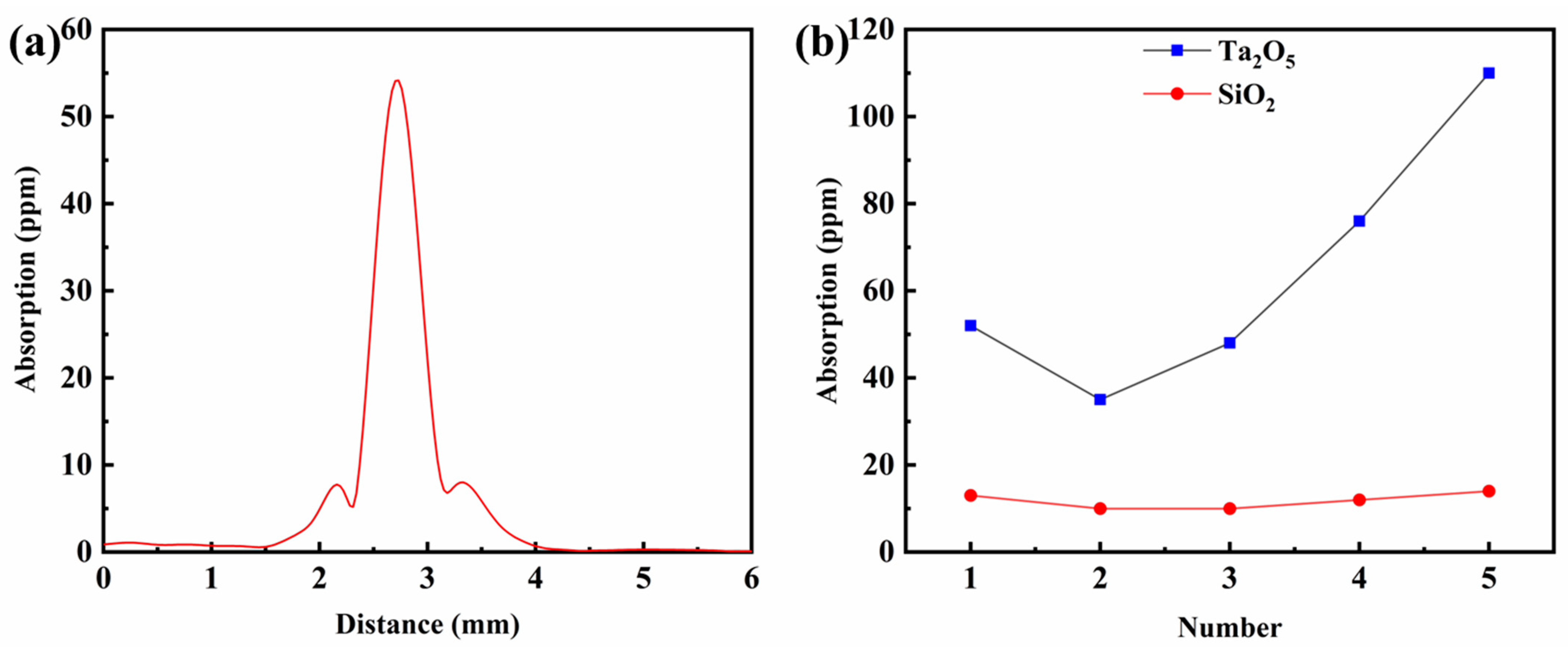
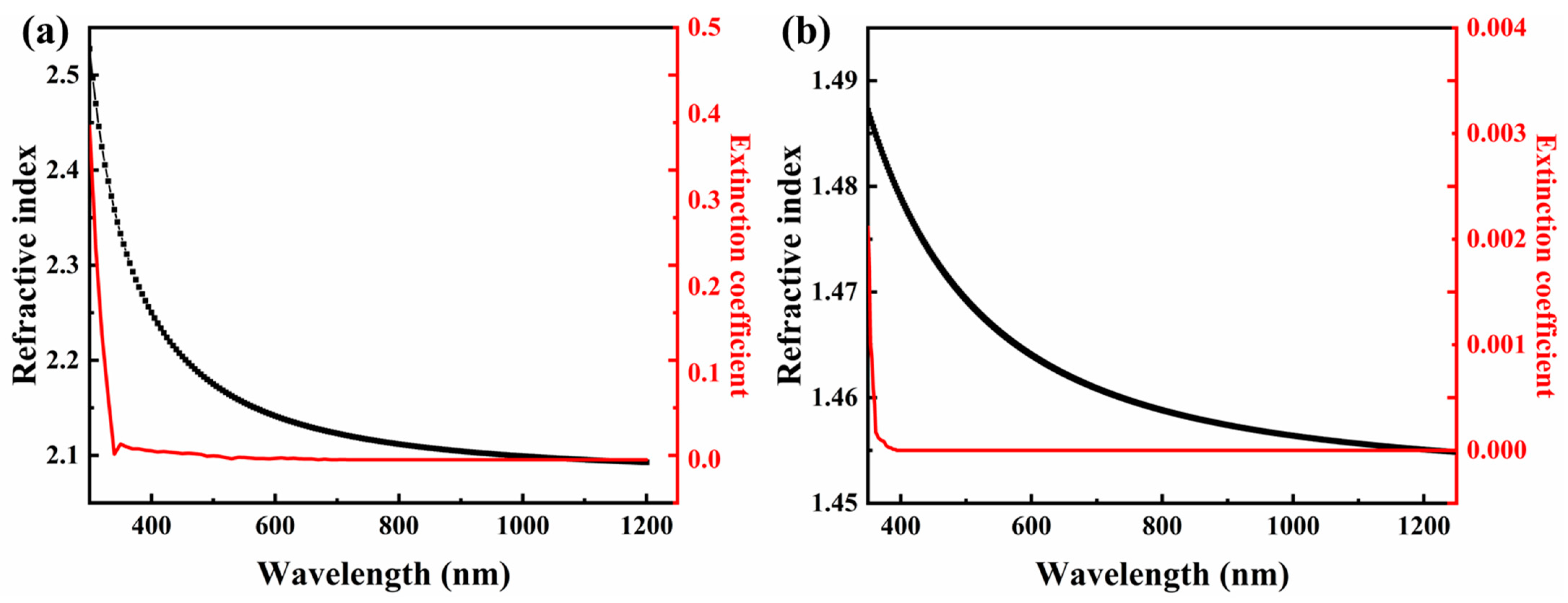

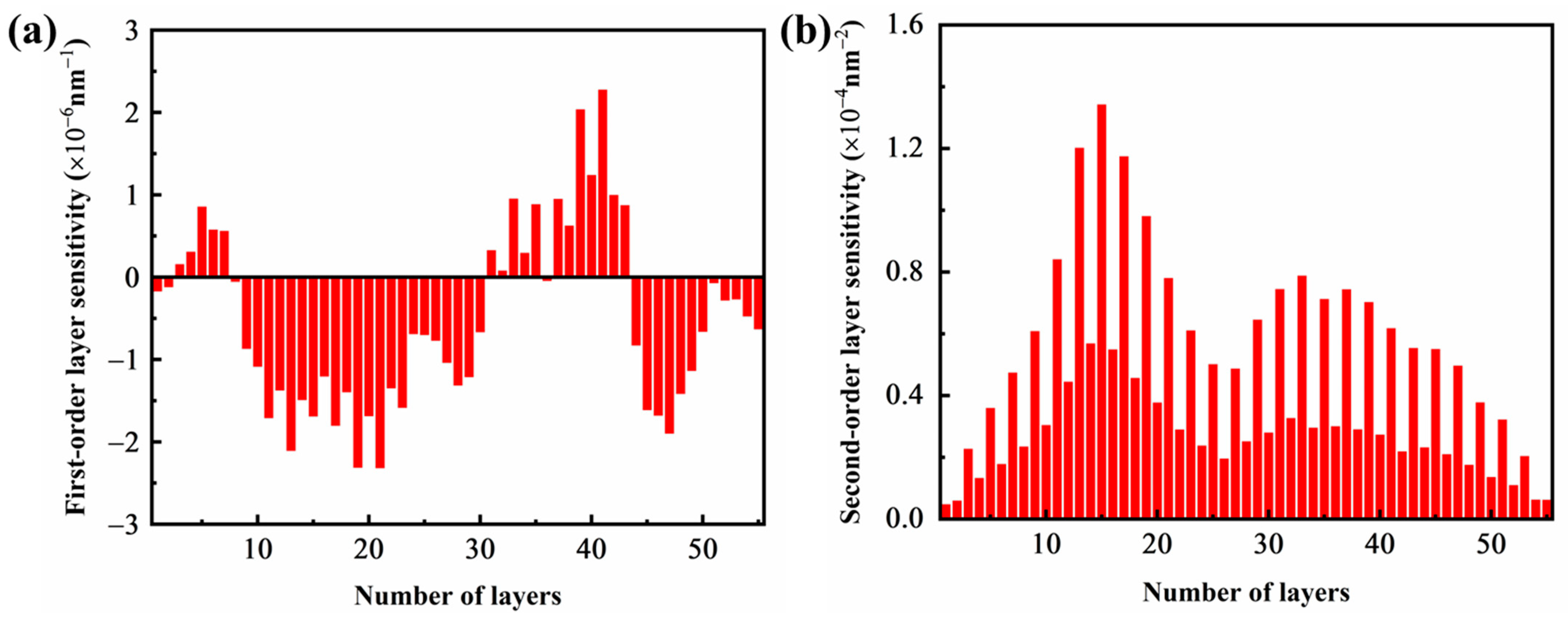
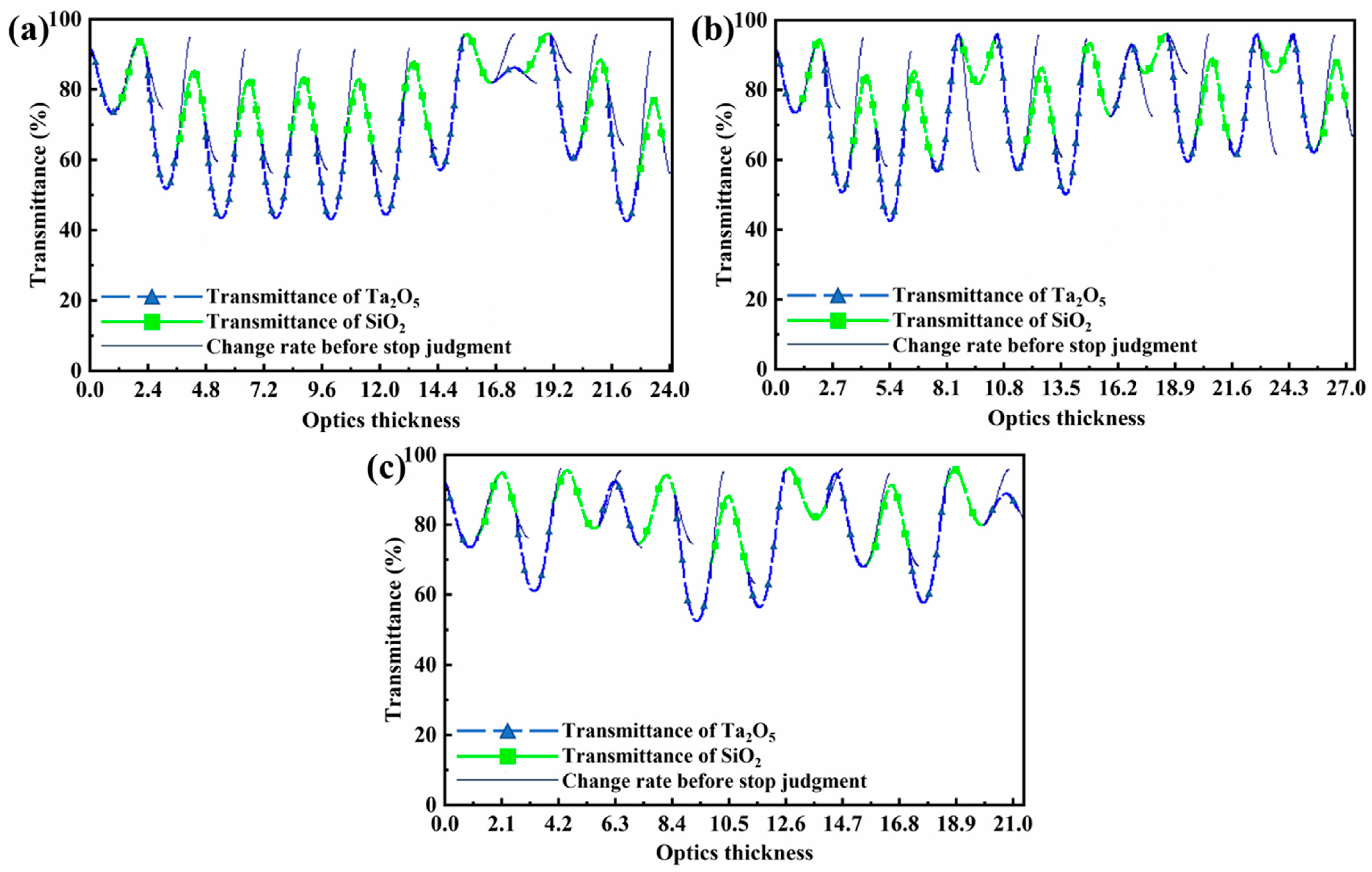
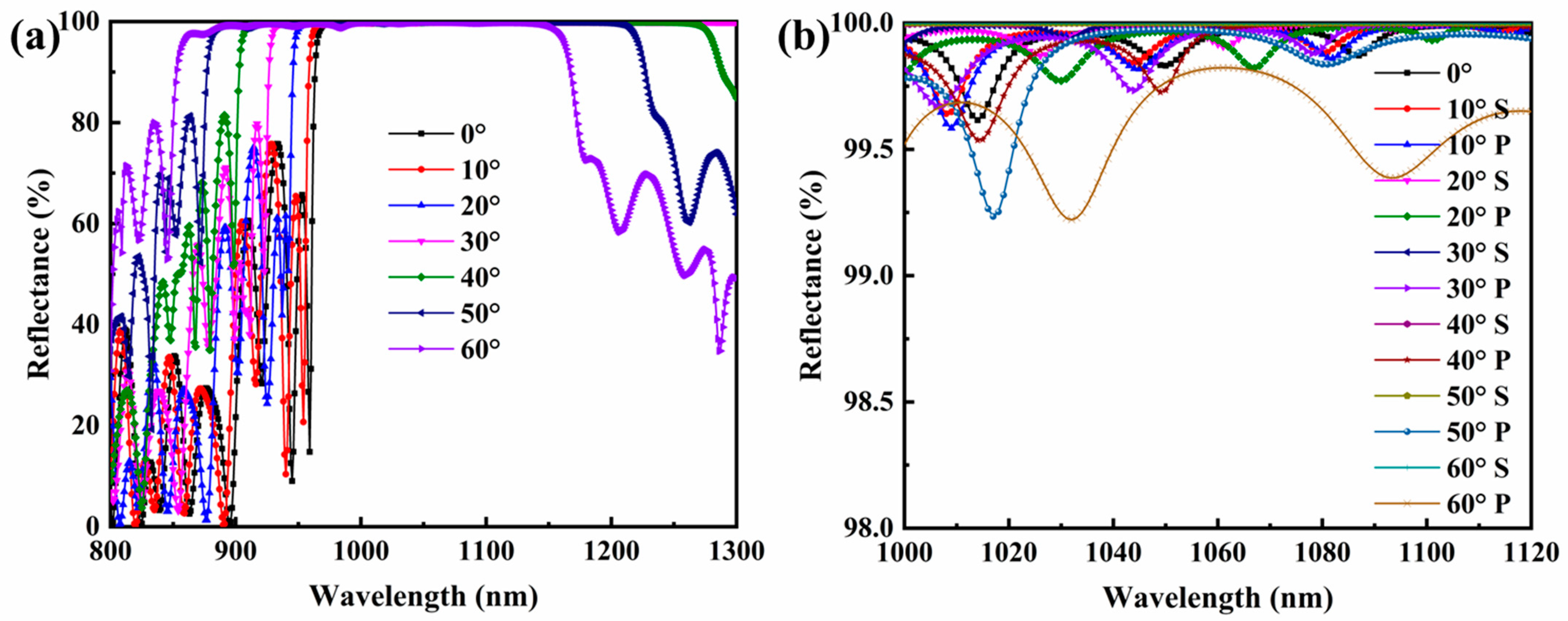
| Parameter | Specification |
|---|---|
| Substrate | BK7 |
| Angle of incidence/(°) | 0~60 |
| Spectrum range/nm | 1064 ± 40 |
| Reflectivity/% | ≥99 |
| |Rp − Rs|/% | ≤1 |
| Materials | Melting Temperature (°C) | Evaporating Temperature (°C) | Density (g/cm3) | Refractive Index | Transparent Region (μm) | Stress |
|---|---|---|---|---|---|---|
| TiO2 | 1850 | 2000 | 4.29 | 2.35 | 0.4~10 | - |
| ZrO2 | 2715 | 2700 | 5.49 | 2.05 | 0.3~12 | tensile stress |
| HfO2 | 2812 | 2700 | 9.68 | 2.00 | 0.22~12 | - |
| Ta2O5 | 1800 | 2100 | 8.74 | 2.16 | 0.35~10 | - |
| MgF2 | 1266 | 1540 | 2.90 | 1.38 | 0.11~10 | tensile stress |
| SiO2 | 1700 | 1600 | 2.10 | 1.46 | 0.2~9 | compressive stress |
| Material | Bias Voltage /V | Coil Current /A | Disch Voltage /V | Disch Current /mA | Ar1 Flow /sccm | Ar2 Flow /sccm | Deposition Rate /(nm/s) |
|---|---|---|---|---|---|---|---|
| Ta2O5 | 130 | 1.45 | 120 | 50 | 2.3 | 10.5 | 0.28 |
| SiO2 | 160 | 1.8 | 130 | 55 | 5 | 7 | 0.7 |
| No. | Flow Rate of O2-APS/sccm | Flow Rate of O2-HPE/sccm |
|---|---|---|
| 1# | 5 | 45 |
| 2# | 15 | 35 |
| 3# | 25 | 25 |
| 4# | 35 | 15 |
| 5# | 45 | 5 |
Disclaimer/Publisher’s Note: The statements, opinions and data contained in all publications are solely those of the individual author(s) and contributor(s) and not of MDPI and/or the editor(s). MDPI and/or the editor(s) disclaim responsibility for any injury to people or property resulting from any ideas, methods, instructions or products referred to in the content. |
© 2023 by the authors. Licensee MDPI, Basel, Switzerland. This article is an open access article distributed under the terms and conditions of the Creative Commons Attribution (CC BY) license (https://creativecommons.org/licenses/by/4.0/).
Share and Cite
Zhu, H.; Jiang, H.; Guo, K.; Peng, Y.; Xin, Y.; Zhang, G.; Lin, Y.; Yang, N.; Wei, H.; Huang, Z.; et al. Development of Wide-Angle Depolarizing Reflector at 1064 nm. Materials 2023, 16, 4258. https://doi.org/10.3390/ma16124258
Zhu H, Jiang H, Guo K, Peng Y, Xin Y, Zhang G, Lin Y, Yang N, Wei H, Huang Z, et al. Development of Wide-Angle Depolarizing Reflector at 1064 nm. Materials. 2023; 16(12):4258. https://doi.org/10.3390/ma16124258
Chicago/Turabian StyleZhu, Han, Hongyan Jiang, Kai Guo, Yongchao Peng, Yawu Xin, Gong Zhang, Yixin Lin, Ning Yang, Huashu Wei, Zekai Huang, and et al. 2023. "Development of Wide-Angle Depolarizing Reflector at 1064 nm" Materials 16, no. 12: 4258. https://doi.org/10.3390/ma16124258




